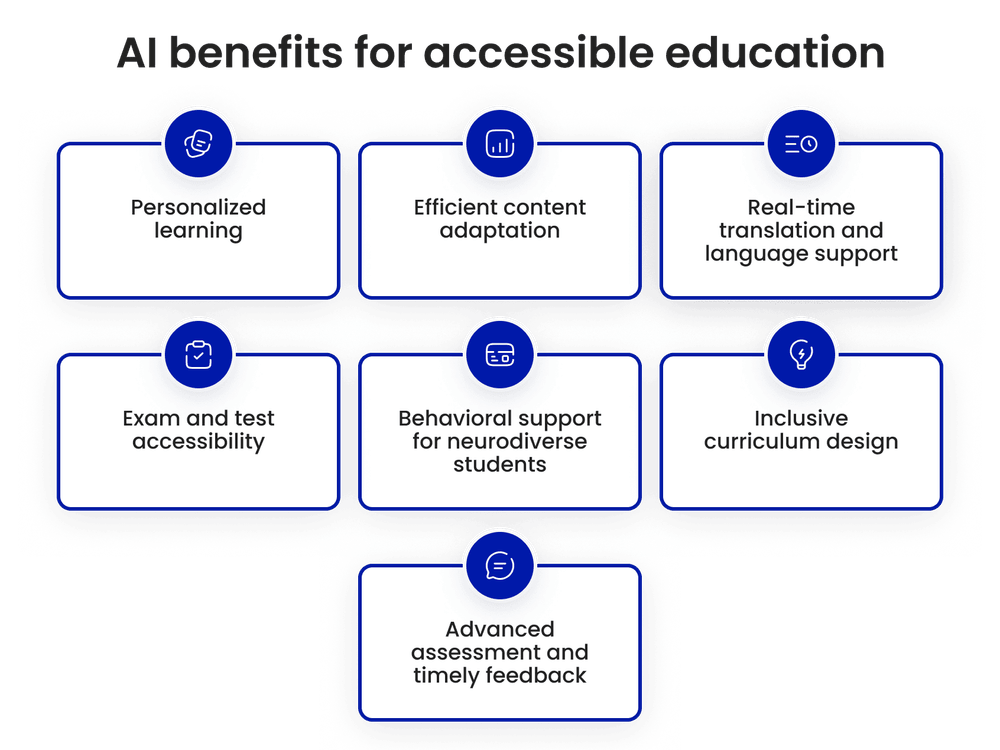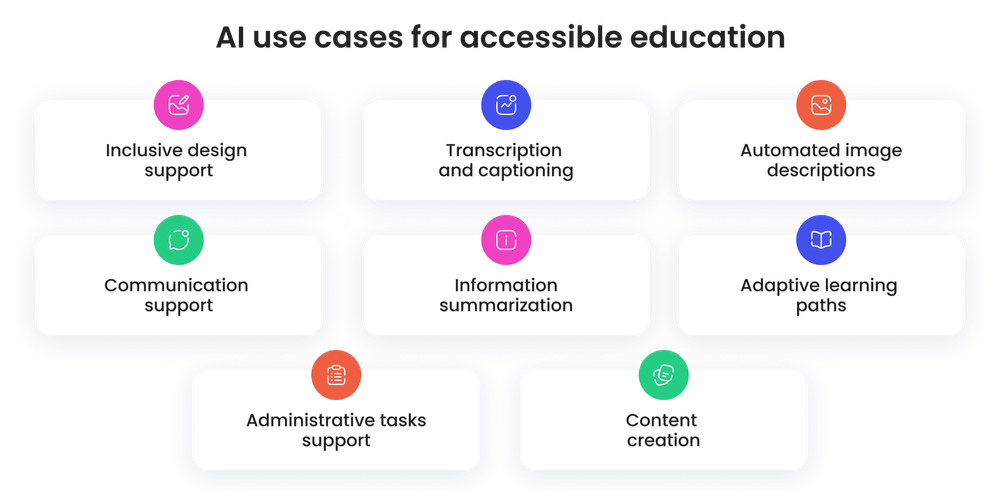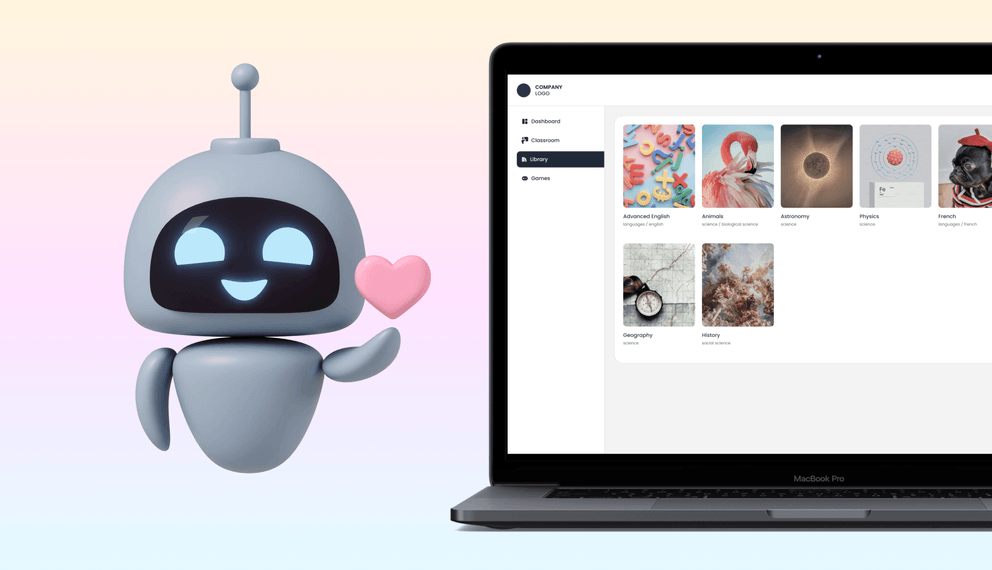The right to quality education is one of the fundamental human rights, just like the right to life, work, or freedom of opinion and expression.
Therefore, making education accessible to everyone is one of the key priorities and most sustainable investments today. Since it’s an effective way to lift adults and kids out of poverty and a stepping stone to other human rights.
The rise of eLearning has offered many incredible opportunities for inclusion, but it’s also presented challenges that need to be addressed.
For example, people with disabilities often struggle with learning platforms, apps, and websites that aren’t designed keeping their needs in mind.
We’ve covered this issue in more detail, highlighting the importance of making design accessible by following WCAG principles.
This time, let’s explore AI’s potential to make education more inclusive, its current uses, benefits, challenges, and actionable tips to ensure AI literacy in classrooms.
The role of AI in inclusion
Over 2.5 billion people need one or more assistive products to help them with cognition, communication, self-care, and improve their well-being, inclusion and participation.
Assistive technology ranges from physical products to digital solutions, like facial recognition for unlocking personal devices, word prediction, and dictation tools, powered by artificial intelligence.
The Fable survey shows that 2 out of 3 respondents say that recent advancements in AI have had a positive effect on their lives.
There’s also a lot of optimism around how AI can continue to improve accessibility and inclusion in the future. The eLearning sphere isn’t an exception.

90% of educators see AI as a beacon for more accessible education, providing personalized learning, efficient content adaptation, real-time translation, language support, and others.
AI use cases for accessible education
Now, we’ll examine AI use cases for accessibility in detail. You’ve definitely come across some. Maybe, though, you haven’t looked at them in that light.

Inclusive design support
For eLearning solutions and materials to be accessible, it’s important for content providers and instructional designers to follow WCAG guidelines.
There are AI tools that can help ensure compliance. For example, Ask Microsoft Accessibility is a free assistant that can be used to create inclusive course materials.
Just ask it questions related to making content more accessible, and AI will suggest several options in real time.
Transcription and captioning
AI-powered speech recognition and natural language processing (NLP) technologies can provide real-time transcriptions and audio/video captioning.
This can greatly benefit students with hearing impairments by ensuring they have access to the same information and resources as their peers.
Сontent creation
AI can assist teachers in creating lesson plans, classroom activities, assignments, and assessments based on the students’ age, grade level, performance, interests, and needs, which promotes personalization and inclusivity.
Educators can use generative AI to present information in a variety of formats (slides, infographics), organize tasks for ease of comprehension, clarify language structures (translate text, explain in lay terms), and other great examples.
AI also makes the work of teachers and content creators easier by taking care of tedious tasks.
For example, traditional manual assessment methods involve individually compiling questions for tests, which is no picnic, especially with large class sizes.
AI tools can generate quizzes automatically, allowing educators to focus more on targeted student interaction rather than administrative tasks.
Automated image descriptions
Content creators must include descriptions, labels, or alt text for pictures so screen readers can interpret the content accurately and effectively help people with visual impairments.
Using AI, these descriptions can be generated automatically, saving time and resources.
Communication support
AI-powered translation tools help people who speak different languages overcome language barriers and communicate more effectively.
What’s more, AI can convert visual input of lip movements into textual or auditory output, which can help people with hearing impairments.
There are also special avatars that can translate spoken and written languages into sign language.

Information summarization
AI can analyze and summarize large amounts of text, making it easier for people with learning difficulties to comprehend complex information efficiently.
For example, individuals with limited attention spans can quickly extract key points from long papers.
Adaptive learning paths
The basic idea of adaptive learning is using technology to offer students individually tailored programs that ensure personalization.
This approach allows learners to progress at their own pace and focus on the areas where they need the most help.
Such adaptability also leads to more inclusive learning because AI tools provide customized support for students with disabilities.
One example of them is intelligent tutoring systems (ITS). They adjust content, pace, and difficulty level in real-time, responding to the unique characteristics, needs, and student performance.
ITS are usually created in the form of chatbots that engage in either textual or auditory conversations with learners.
Chatbots in education provide quick and universal access to information and keep users motivated. That’s why students sometimes prefer to use them for information retrieval over traditional methods.
AI-driven Q&A system for learners
We created a 24/7 tutor that provides a vast variety of tailored explanations and examples for complex concepts, resolving student questions in seconds.

Educators support
AI can automate tasks like grading, attendance tracking, lesson planning, and other activities that often lead to teacher burnout.
For example, Individualized Education Programs (IEPs) are a vital part of the job of a special education teacher, as they tailor educational plans to meet the unique needs of students with disabilities.
Yet, creating these documents is a complex process that can take weeks to complete.
Responsible implementation of AI in the creation of IEPs allows teachers to generate strategies to support IEP goals, minimize paperwork, reduce their workload and turnover, and improve job satisfaction.
A.I. as in Accessibility & Inclusion?
Being very helpful for promoting accessibility, AI still causes several fair concerns. Let’s probe deeper.
1. Algorithmic bias
Unfortunately, not all AI tools work correctly for some students with disabilities. The common reason is algorithmic bias.
What’s that? Picture the following scenario:
An AI grading tool was created to assess written responses according to accepted grammatical standards, without keeping different students in mind.
As a result, it could unjustly penalize students with learning difficulties like dyslexia, who may have trouble with grammar and spelling but show a deep understanding of material.
In fact, a variety of groups may experience discrimination on the basis of age, sex, race, ethnicity and others, because of the algorithmic bias.
To deal with this issue, organizations would need to adopt more ethical practices, focus on how they source and process data, design and monitor their AI tools to address bias effectively.
Finding better metrics and ensuring proper data collection to assess algorithmic bias also helps to catch many forms of it.
It’s a challenge as disability is not all the same, and data that represents all types can be hard to collect. But still possible.
This leads us to another big issue — not including people with disabilities in the AI development process.
2. Inadequate representation
According to the Fable survey, fewer than 7% of respondents with disabilities believe there is adequate representation of their community in the creation of AI tools. And this is a huge omission.
If AI is trained on a narrow “definition” of disability, the result won’t be accessible. For example, if data from people who stutter isn’t used to train a voice-activated tool.
That’s why it’s vital to include different groups of people with disabilities not only in AI fairness conversations but also in the development of AI products.
They must be created by diverse people and trained on diverse datasets to avoid inaccuracies and ensure true representation, especially for students with disabilities.
By the way, 87% of survey respondents said they would be willing to participate and provide end-user feedback to developers.
3. Data privacy
In order to work efficiently, AI systems typically need a great deal of personal data, such as names, addresses, medical records, academic transcripts, and more.
If this data isn’t well protected, it may be vulnerable to hacking, data leaks, or misuse.
As a result, sharing Personal Identifiable Information (PII) could lead to non-compliance with privacy policies such as FERPA, CISA, etc.
How to use AI and stay protected?
Discover how to safeguard your data, ensure compliance, and build trust with our AI security whitepaper.
4. Access to AI tools
As students have different levels of access to technology, integrating AI into the classroom can also present challenges for equity and inclusion. This is called the “digital divide.”
Since technical factors (tech availability, broadband speed, internet access) and social ones (e.g., gender, age, income, family size, educational level) impact who accesses AI tools, some of the groups can be left out.
Therefore, it is important for educational organizations to consider these factors to ensure that all students have equal opportunities for learning and growth and provide necessary resources to those who may be at a disadvantage.
Introducing AI to classrooms
To make AI an ally in making education both efficient and accessible, you have to ensure its ethical use. That’s why AI literacy is important.
AI literacy is the ability to understand, use, and critically reflect on AI applications. An AI-ready person can decide how, when, and if they want to engage with AI.
To introduce AI literacy to the classroom, educators have to be AI-ready first.
To help teachers with lifelong professional development, UNESCO offered the AI competency framework.
It aims to ensure that educators are equipped to use AI responsibly and effectively while minimizing potential risks to students and society.
There is also the AI competency framework for students. It’s designed to guide policy-makers, educators, and curriculum developers in equipping students with the necessary skills, knowledge, and values to engage with AI safely and efficiently.
It assists educators in providing foundational AI knowledge and skills, teaching responsible use and safe practices, fostering problem-solving, creativity, and more.
Here are some steps that you can start using now:
1. Apply accessibility guidelines
It’s important to ensure that basic accessibility principles and practices are applied when using AI in the classroom.
For instance, AI-generated content should have alt text for images, headings to break up lengthy text passages, clear language, etc.
When students need to use AI for an assignment, the AI tool itself should be keyboard navigable and accessible to assistive technologies such as screen readers.
2. Adapt courses
To adapt courses to the use of AI tools, you don’t have to undo the progress you have already made in making them more accessible.
Instead, use AI to help redesign course elements to address academic integrity concerns while maintaining the flexibility and variety provided by the UDL framework.
3. Review AI content
As we’ve already mentioned, AI offers various opportunities for accessibility and inclusion. For example, you can use it for creating classroom activities, assignments, and assessments.
Yet, don’t forget about algorithmic bias. Because of this, always review AI-generated content to check for the accuracy of content claims, biased language, and diverse representation.
This step is crucial to ensure that the content aligns with the principles of academic integrity and inclusivity.
By reviewing AI-generated content, educators can make necessary adjustments to promote a fair and unbiased learning environment for all students.
Final words
By incorporating AI into education, we can create more equitable opportunities for students with disabilities, remove barriers to learning, and enhance engagement.
AI tools assist with many aspects, like content creation, language support, inclusive design, and others. Despite being highly efficient, AI raises several concerns. Algorithmic bias and the digital divide are among them.
That’s why it’s important that AI systems are both developed and implemented into the classroom with careful consideration of ethical standards and inclusivity.
Excited to create a truly one-of-a-kind learning experience for each student, ensuring accessibility and security? Talk to our experts.





